?Sipping, swirling, and savoring the delights of Switzerland’s vineyards – from the right glassware to the perfect serving temperature! ?

The Importance of Temperature
The serving temperature of a wine is the most important criterion for the aromas to be released intensely. (chateauberne-vin.com)
Serving wine at the correct temperature can significantly enhance its aroma, flavor, and overall drinking experience. But what’s the correct temperature to serve your wine?
What’s the correct temperature to serve your wine?
White & Rosé Wine

White wines and rosés are best served chilled to highlight their refreshing characteristics. The perfect temperature range preserves their delicate aromas and crisp acidity, ensuring a delightful sip with every pour.
Ideal Temperature: 7°C to 13°C
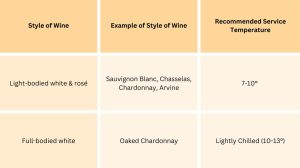
Red Wine

Red wines benefit from a slightly warmer serving temperature to unlock their full bouquet of flavors. This slight warmth allows the aromas to evolve, the tannins to soften, and the complexity of flavors to shine through, providing a rich and satisfying experience. Read here more about what light-, medium-, and full-bodied means.
Ideal Temperature: 13°C to 18°C
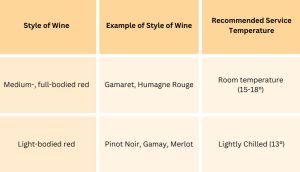
Champagne

Champagne deserves special attention when it comes to serving temperature. To fully appreciate its fine bubbles and nuanced flavors, Champagne should be served colder than other wines. This cooler temperature maintains the wine’s freshness and preserves its signature effervescence, making each sip a celebration.
Ideal Temperature: 6°C to 10°C.
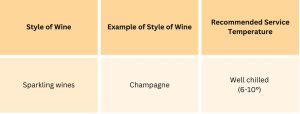
Opening a Bottle of Still Wine – Step by Step Guide
Learn here (?) how to nicely open a bottle of Still Wine.
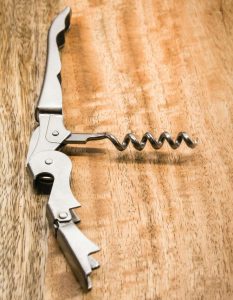
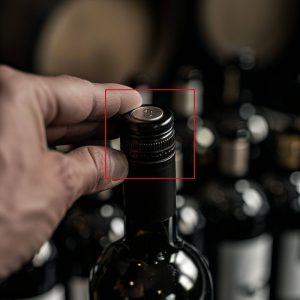

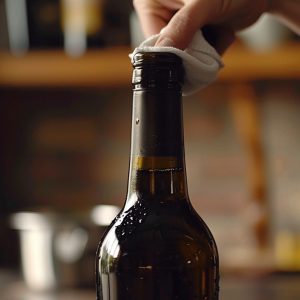
Step 1
Remove the top of the capsule with a capsule remover or a waiters friend corkscew.
Step 2
Insert the corkscrew into the center of the cork. Twist it into the cork until it is nearly all the way in, then gently pull the cork out.
Step 3
Wipe around and inside of the neck with a cloth.
TIP: It takes about seven turns to insert the worm into the best spot, although wine openers vary. Basically, the corkscrew should be inserted into the cork about one turn less than all the way in. (Winefolly.com)
Opening a Bottle of Sparkling Wine – Step by Step Guide
To learn how to properly open a bottle of Sparkling Wine, check out the video (?) here (01:05-01:50).
Step 1

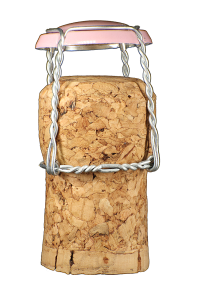
Step 2
Hold the bottle at an angle. Hold the cork with one hand and the bottom of the bottle with the other. Turn the bottle, not the cork!
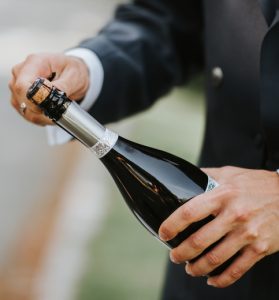
Step 3
Hold the cork tightly so the pressure in the bottle doesn’t push the cork out too fast. This way, the pressure can release with a quiet “pop” and no wine will be lost.

Swiss Wine Serving Tips
- Check the wine’s appearance: Any cloudiness might mean the wine is bad.
- Check for floating bits: Ensure there are none in the wine.
- Check the aroma: The wine should not smell stale or have aromas of wet cardboard or vinegar.
- Use appropriate glasses: Enhance the aroma and taste of Swiss wines with the right glassware. For example, use a narrow flute for Champagne and a larger bowl-shaped glass for red wines. Check out my blog post “A Beginner’s Guide to Swiss Wine Tasting” for more details.
Does Wine Go Bad?
Yes, wine can go bad. After opening, a bottle of wine is generally only as tasty for 1-2 days. To extend its life, use a high-quality wine bottle resealing cork that lets you pump out excess air. (toast)
Some Key Wine Terms and Information
- Tannins – the chemical compounds in grapes that are detectable by our olfactory senses, taste, and smell, are called tannins. The same compound is responsible for the taste of coffee.
- Tannins are contained in the skin of the wine. Red wines are dryer because they have more tannins, whereas white wines are sweeter because green grapes naturally have more sugar.
- Dry – tannins are responsible for the “dry” mouthfeel of wine and dryness refers to the scale of tannins in wines. Higher tannin content makes a dryer wine.
- Sweet– sweetness is determined by how much sugar, whether natural or added, is in a wine.
- Some wines are named for the region in which the grapes were grown, such as champagne (Champagne, France).
Show me what you learned – drop your guess in the comment section!
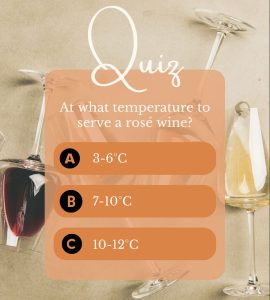
?You want to learn more about Swiss Wine? Then check out the following articles ⬇️
- Exploring Swiss Wine Regions: Unveilling The Terroir
- A Beginner’s Guide to (Swiss) Wine Tasting.
- Swiss Wine Varieties: Indigenous Grapes
- Which Wine Goes Well With My Food
- 3 Swiss Female Winemakers You Should Remember
- Biodynamic Wines
Eager for more insights into Swiss Wine? Follow me on Instagram for a behind-the-scenes look at the vibrant world of Swiss viticulture! ![]()
Sources:
- All pictures have been generated via Midjourney and the Quiz as well as the figures with Canva.
- Only the pictures needing further explanation have a caption.




Congratulations on wrapping up this beautiful blog. Informative, aesthetic and very well done.❤️
Hi Mariza
Thank you so much for your kind words! I’m thrilled you enjoyed the blog. Your support means a lot to me! ❤️
Cheers, Chloé
super helpful guide – thanks! ?✨️?
Hi Nadja
Thanks so much for your lovely feedback, I’m happy you liked the guide 🙂
Keep drinking Swiss Wine!
Cheers, Chloé
Wow, well done!
Liked the blog very much.
Hi Andrea
Thanks a lot for your nice feedback 🙂 I am super happy to read that you liked the blog! Hope you learned some useful things.
Enjoy your next wine evening! And if ever you need any recommendations, let me know.
Cheers, Chloé
Very well put together and easily rememberable guide, well done! But as an italian I have to say no mention of prosecco but champagne? ??
Hi Diego
Thank you for the kind words! I’m glad you found the guide helpful and easy to remember. You’re absolutely right—Prosecco definitely deserves a mention alongside Champagne! I’ll make sure to include it in future posts. Cheers to the Italian bubbles! ???
Chloé
A good way to wrap up this blog. Thanks for the insights, it was very pleasent to read.
Hi Leandro
Thank you so much for your kind words! I’m glad you enjoyed the blog and found the insights valuable. Your feedback means a lot and motivates me to keep sharing more content.
Cheers, Chloé
Answer: Temperature to serve rosé wine 7-10 Grad
Hi Regula
Well done, that’s absolutely correct! ?
Next time I see, I shall make sure to bring you a bottle of rosé.
Cheers, Chloé
Thank you for these very interesting information about wine! I learned a lot – it is like a wine academy?. I‘m looking forward to get more information from you❣️
Hi Regula
Thank you for your wonderful comment! I’m thrilled to hear that you found the information about wine both interesting and educational, like a wine academy?. There’s so much more to explore and share, and I’m excited to continue this journey with you. Stay tuned for more wine insights – there will be more, even if this university project is now over❣️
Cheers, Chloé
Thanks Chloé, now I finally know how to do it properly when inviting friends over next time ?
Hi Mélanie
You’re welcome! I’m so glad to hear that you found the tips helpful for your next gathering ?. Enjoy hosting your friends, and feel free to reach out if you need more advice or have any questions in the future!
Cheers, Chloé
Very interesting blog again? I never knew that after opening the bottle of wine you are supposed to whipe the neck with a cloth. I will remember to do that with my next wine?
Hi Sandra,
Thank you so much! ? I’m glad you found the tip useful. It’s a small step, but it can really enhance the wine-tasting experience. Do you have a favorite type of wine you enjoy? ?
Cheers, Chloé
I like white wines very much! Especially from the region Valais☺️ But also sparkling wines are nic at the right occasion. You never go wrong with a sweet Muscato?
Hi Sandra
I totally agree with you – a sweet Moscato is always a good idea! 🙂
Also, have you ever tried a Pinot Gris from Les Frères Dutruy? Canton Waadt 🙂 I think you would absolutely love it.
https://www.lesfreresdutruy.ch/all-our-wines/
Cheers,
Chloé
Just amazing!❤️ I have read all of your blogs and learned so much about wine?Great work Chloé!
Hi Nicole
Thank you so much for your kind words and support! ❤️ It means a lot to hear that you’ve enjoyed and learned from my blogs.
Cheers to more wine adventures – check out my instagram for more content! ??
Chloé
Very interesting that with sparkling wine you have to turn the bottle and not the cork? I always did that wrong. Thank you for sharing that information☺️
Hi Nina
I’m glad you found the information about opening sparkling wine useful! Yes, turning the bottle rather than the cork helps to control the pressure and prevent spills or accidents – also something I just learnt recently, but is super interesting. If you have any more questions about wine, drinks, or anything else, feel free to ask! Cheers! ?
Chloé
Super interesting Blog!
I am indeed a beginner in wine knowledge and super excited about this input. Looking forward to more posts❤️?
Hi Ylenia
Thanks a lot for your enthusiastic response! ? I’m delighted to hear that you found the blog interesting, especially as a beginner in the world of wine. ? I’ll definitely keep the posts coming, so stay tuned for more wine-related content on my Instagram https://www.instagram.com/swisssipvoyage/! ?❤️ Cheers, Chloé